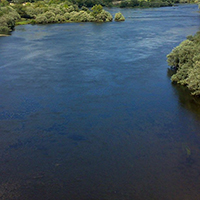Influence of wastewater discharges on benthic macroinvertebrate communities in a Cantabrian-Atlantic coastal river

Submitted: 15 March 2021
Accepted: 7 October 2021
Published: 25 October 2021
Accepted: 7 October 2021
Abstract Views: 2382
PDF: 356
HTML: 125
HTML: 125
Publisher's note
All claims expressed in this article are solely those of the authors and do not necessarily represent those of their affiliated organizations, or those of the publisher, the editors and the reviewers. Any product that may be evaluated in this article or claim that may be made by its manufacturer is not guaranteed or endorsed by the publisher.
All claims expressed in this article are solely those of the authors and do not necessarily represent those of their affiliated organizations, or those of the publisher, the editors and the reviewers. Any product that may be evaluated in this article or claim that may be made by its manufacturer is not guaranteed or endorsed by the publisher.
Similar Articles
- Xing Wang, Binghui Zheng, Lusan Liu, Lijing Wang, Development and evaluation of the Lake Multi-biotic Integrity Index for Dongting Lake, China , Journal of Limnology: Vol. 74 No. 3 (2015)
- Letícia de Morais, Bárbara de Oliveira Sanches, Gilmar B. Santos, Philip R. Kaufmann, Robert M. Hughes, Joseline Molozzi, Marcos Callisto, Assessment of disturbance at three spatial scales in two large tropical reservoirs , Journal of Limnology: Vol. 76 No. 2 (2017)
- Angela Boggero, Lyudmila Kamburska, Silvia Zaupa, Marzia Ciampittiello, Michela Rogora, Tiziana Di Lorenzo, Synoptic results on the potential impacts of the Lake Maggiore water management strategy on freshwater littoral ecosystems and invertebrate biocoenosis (NW, Italy) , Journal of Limnology: Vol. 81 No. s2 (2022): Effects of water level management on lake littorals and downstream river areas
- Erica E. Scheibler, M. Cristina Claps, Sergio A. Roig-Juñent, Temporal and altitudinal variations in benthic macroinvertebrate assemblages in an Andean river basin of Argentina , Journal of Limnology: Vol. 73 No. 1 (2014)
- Ruben Ladrera, Miguel Cañedo-Argüelles, Narcís Prat, Impact of potash mining in streams: the Llobregat basin (northeast Spain) as a case study , Journal of Limnology: Vol. 76 No. 2 (2017)
- Laura Sartori, Sergio Canobbio, Riccardo Cabrini, Riccardo Fornaroli, Valeria Mezzanotte, Macroinvertebrate assemblages and biodiversity levels: ecological role of constructed wetlands and artificial ponds in a natural park , Journal of Limnology: Vol. 74 No. 2 (2015)
- Enlou Zhang, Boying Zheng, Yanmin Cao, Guang Gao, Ji Shen, Influence of environmental parameters on the distribution of subfossil chironomids in surface sediments of Bosten lake (Xinjiang, China) , Journal of Limnology: Vol. 71 No. 2 (2012)
- Juta Haberman, Marina Haldna, Indices of zooplankton community as valuable tools in assessing the trophic state and water quality of eutrophic lakes: long term study of Lake Võrtsjärv , Journal of Limnology: Vol. 73 No. 2 (2014)
- Maria V. López van Oosterom, Carolina Ocon, Laura C. Armendariz, Alberto Rodrigues Capitulo, Structural and functional responses of the oligochaete and aeolosomatid assemblage in lowland streams: a one-way-pollution-modelled ecosystem , Journal of Limnology: Vol. 74 No. 3 (2015)
- Carolina Nieto, Daniel A. Dos Santos, Andrea E. Izquierdo, José S. Rodríguez, Héctor R. Grau, Modelling beta diversity of aquatic macroinvertebrates in High Andean wetlands , Journal of Limnology: Vol. 76 No. 3 (2017)
You may also start an advanced similarity search for this article.

 https://doi.org/10.4081/jlimnol.2021.2014
https://doi.org/10.4081/jlimnol.2021.2014





